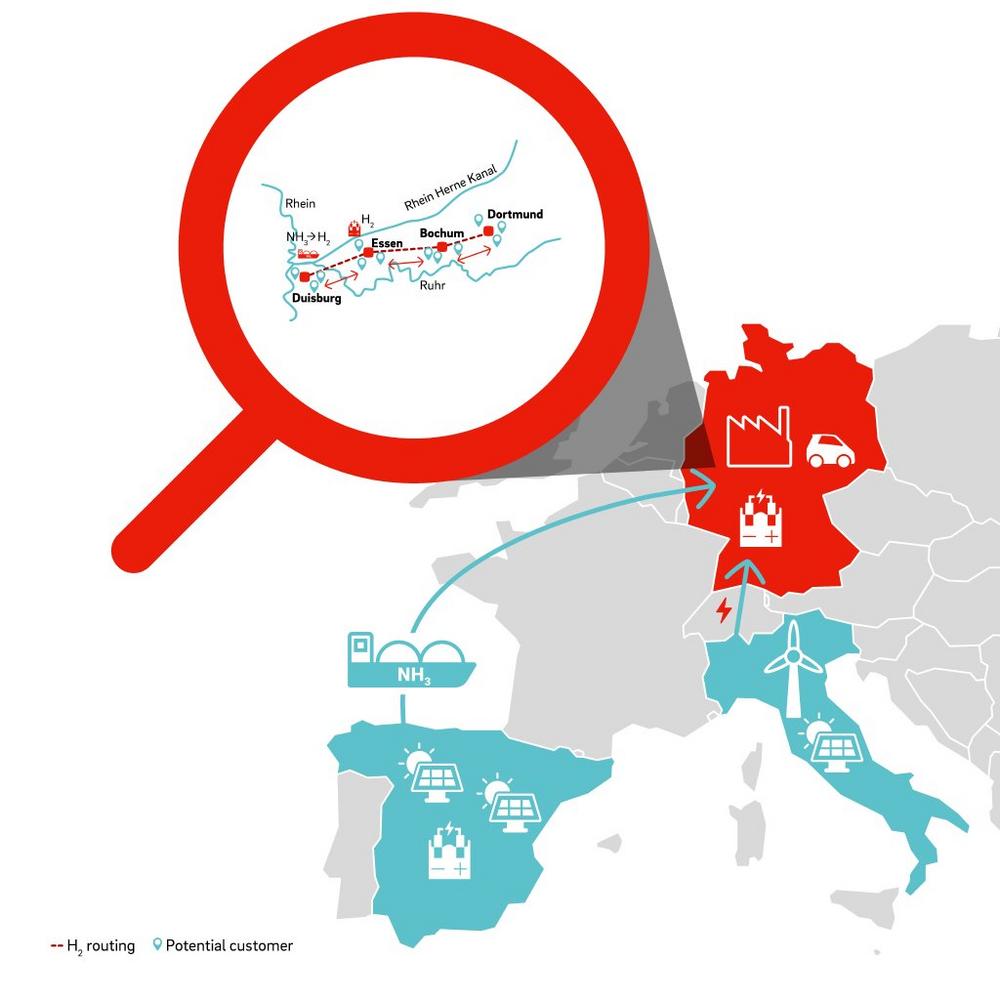• “H2.Ruhr” project is to deliver up to 80,000 tonnes of green hydrogen and green ammonia per year to customers in the Ruhr region
• E.ON determines the needs of industry and municipalities as part of a market survey
• Energy companies Enel and Iberdrola are to provide green electricity and ammonia as members of the European CEO Alliance
The energy company E.ON is planning to set up a distribution network and corresponding infrastructure for hydrogen and ammonia in the Ruhr region as part of a European cooperation project. The “H2.Ruhr” project is intended to give municipal, medium-sized and industrial companies in the region access to CO2-free hydrogen and green ammonia.
E.ON is planning to set up a European hydrogen value chain together with the energy companies Enel and Iberdrola. The energy required is to come primarily from newly built photovoltaic and wind power plants in Italy and Spain. From 2032, up to 80,000 tonnes of hydrogen per year could be available for regional customers. The project is part of the CEO Alliance, in which twelve leading European companies are jointly promoting cross-sector and cross-border projects for more climate protection.
Leonhard Birnbaum, CEO of E.ON: “Green hydrogen is the only truly sustainable option for decarbonising industrial processes. For this, we will require much more hydrogen in Germany long term, than we can produce ourselves. What we need are strong pan-European partnerships and efficient supply chains, which must be established now. Our ambition at E.ON is to move forward quickly and concretely in building a green hydrogen economy. H2.Ruhr is a good and pioneering example of this.”
In the Ruhr region, a considerable increase in the demand of hydrogen can be expected in the future: from the present 17 terawatt hours annually, to up to 150 terawatt hours in 2050. More and more municipal companies, SMEs and corporations are looking for ways to obtain green hydrogen in the short term in order to make their operational processes climate-friendly. A major goal of the H2.Ruhr project is therefore the development of a pipeline network for efficient distribution and cost-optimised supply to regional customers. The necessary infrastructure is to be built in several expansion stages by 2032.
E.ON wants to support companies in the Ruhr region on their way to a climate-neutral future. In the current project phase, one of the first tasks is to identify specific needs in the region. To do this, E.ON is actively approaching existing and potential customers. Companies can get in touch and get involved via the created project website www.eon.com/en/h2ruhr.
Katherina Reiche, CEO of Westenergie AG and Chairwoman of the National Hydrogen Council: “In addition to large corporations, the many medium-sized companies in the region also need green hydrogen. This is the only way they can achieve their climate goals. The development of a hydrogen economy is essential for many small and medium-sized enterprises – and thus for hundreds of thousands of jobs in Germany. With H2.Ruhr, we offer these companies perspective for their future and make an important contribution to maintaining the Ruhr area as the industrial heart of Germany. The more companies start switching to green hydrogen earlier, the more economically it can be.”
Project in detail: With hydrogen and ammonia into the green energy future
The project envisages the production of green electricity in wind and photovoltaic plants in Italy and Spain to benefit from the better availability of renewable energies in these countries. The electricity will be used to produce green hydrogen through electrolysis. In Spain, the hydrogen will be used to produce ammonia, which is then transported to Germany by ship. The import is expected to start in 2024. Depending on demand, the green ammonia will be delivered directly to customers or stored temporarily for later use. At the same time, E.ON is investigating the extent to which ammonia can be efficiently converted back into hydrogen and made available in the Ruhr region as part of the project.
From Italy, green electricity is to be exported and used for producing hydrogen in Germany. For this purpose, the construction of a local electrolyser with an initial capacity of 20 megawatts is planned until 2025. The capacity will be continuously expanded. The green hydrogen produced either from ammonia or by means of electrolysis will be fed directly into the grid and distributed to the companies. This way, a new regional hydrogen pipeline network between Duisburg and Dortmund is to be successively created by 2032.
The H2.Ruhr project is subject to the availability of funding and a review by the European antitrust authority.
This press release may contain forward-looking statements based on current assumptions and forecasts made by E.ON Group Management and other information currently available to E.ON. Various known and unknown risks, uncertainties, and other factors could lead to material differences between the actual future results, financial situation, development or performance of the company and the estimates given here. E.ON SE does not intend, and does not assume any liability whatsoever, to update these forward-looking statements or to align them to future events or developments.
E.ON SE
E.ON-Platz 1
40479 Düsseldorf
Telefon: +49 (201) 18400
Telefax: +49 (211) 4579515
http://www.eon.com/
Telefon: +49 (173) 6840253
E-Mail: isabel.reinhardt@eon.com
![]()
